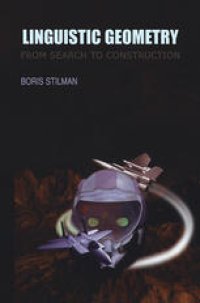
Ebook: Linguistic Geometry: From Search to Construction
Author: Boris Stilman (auth.)
- Tags: Artificial Intelligence (incl. Robotics), Operations Research Management Science
- Series: Operations Research/Computer Science Interfaces Series 13
- Year: 2000
- Publisher: Springer US
- Edition: 1
- Language: English
- pdf
Linguistic Geometry: From Search to Construction is the first book of its kind. Linguistic Geometry (LG) is an approach to the construction of mathematical models for large-scale multi-agent systems. A number of such systems, including air/space combat, robotic manufacturing, software re-engineering and Internet cyberwar, can be modeled as abstract board games. These are games with moves that can be represented by the movement of abstract pieces over locations on an abstract board. The purpose of LG is to provide strategies to guide the games' participants to their goals. Traditionally, discovering such strategies required searches in giant game trees. These searches are often beyond the capacity of modern and even conceivable future computers.
LG dramatically reduces the size of the search trees, making the problems computationally tractable. LG provides a formalization and abstraction of search heuristics used by advanced experts including chess grandmasters. Essentially, these heuristics replace search with the construction of strategies. To formalize the heuristics, LG employs the theory of formal languages (i.e. formal linguistics), as well as certain geometric structures over an abstract board. The new formal strategies solve problems from different domains far beyond the areas envisioned by the experts. For a number of these domains, Linguistic Geometry yields optimal solutions.
Linguistic Geometry: From Search to Construction is the first book of its kind. Linguistic Geometry (LG) is an approach to the construction of mathematical models for large-scale multi-agent systems. A number of such systems, including air/space combat, robotic manufacturing, software re-engineering and Internet cyberwar, can be modeled as abstract board games. These are games with moves that can be represented by the movement of abstract pieces over locations on an abstract board. The purpose of LG is to provide strategies to guide the games' participants to their goals. Traditionally, discovering such strategies required searches in giant game trees. These searches are often beyond the capacity of modern and even conceivable future computers.
LG dramatically reduces the size of the search trees, making the problems computationally tractable. LG provides a formalization and abstraction of search heuristics used by advanced experts including chess grandmasters. Essentially, these heuristics replace search with the construction of strategies. To formalize the heuristics, LG employs the theory of formal languages (i.e. formal linguistics), as well as certain geometric structures over an abstract board. The new formal strategies solve problems from different domains far beyond the areas envisioned by the experts. For a number of these domains, Linguistic Geometry yields optimal solutions.
Linguistic Geometry: From Search to Construction is the first book of its kind. Linguistic Geometry (LG) is an approach to the construction of mathematical models for large-scale multi-agent systems. A number of such systems, including air/space combat, robotic manufacturing, software re-engineering and Internet cyberwar, can be modeled as abstract board games. These are games with moves that can be represented by the movement of abstract pieces over locations on an abstract board. The purpose of LG is to provide strategies to guide the games' participants to their goals. Traditionally, discovering such strategies required searches in giant game trees. These searches are often beyond the capacity of modern and even conceivable future computers.
LG dramatically reduces the size of the search trees, making the problems computationally tractable. LG provides a formalization and abstraction of search heuristics used by advanced experts including chess grandmasters. Essentially, these heuristics replace search with the construction of strategies. To formalize the heuristics, LG employs the theory of formal languages (i.e. formal linguistics), as well as certain geometric structures over an abstract board. The new formal strategies solve problems from different domains far beyond the areas envisioned by the experts. For a number of these domains, Linguistic Geometry yields optimal solutions.
Content:
Front Matter....Pages i-xiv
Introduction....Pages 1-38
Hierarchy of Formal Languages....Pages 39-76
Robot Combat for 2D District....Pages 77-90
Expanding to 3D Space....Pages 91-106
Deeper Search, More Agents....Pages 107-135
Concurrency, n?n District....Pages 137-163
Scheduling: Artificial Conflict....Pages 165-180
Generating Techniques....Pages 181-191
Language of Trajectories....Pages 193-234
Language of Zones....Pages 235-257
Translations....Pages 259-286
Languages of Searches....Pages 287-303
From Search to Construction....Pages 305-339
Computational Complexity....Pages 341-360
Back Matter....Pages 361-395
Linguistic Geometry: From Search to Construction is the first book of its kind. Linguistic Geometry (LG) is an approach to the construction of mathematical models for large-scale multi-agent systems. A number of such systems, including air/space combat, robotic manufacturing, software re-engineering and Internet cyberwar, can be modeled as abstract board games. These are games with moves that can be represented by the movement of abstract pieces over locations on an abstract board. The purpose of LG is to provide strategies to guide the games' participants to their goals. Traditionally, discovering such strategies required searches in giant game trees. These searches are often beyond the capacity of modern and even conceivable future computers.
LG dramatically reduces the size of the search trees, making the problems computationally tractable. LG provides a formalization and abstraction of search heuristics used by advanced experts including chess grandmasters. Essentially, these heuristics replace search with the construction of strategies. To formalize the heuristics, LG employs the theory of formal languages (i.e. formal linguistics), as well as certain geometric structures over an abstract board. The new formal strategies solve problems from different domains far beyond the areas envisioned by the experts. For a number of these domains, Linguistic Geometry yields optimal solutions.
Content:
Front Matter....Pages i-xiv
Introduction....Pages 1-38
Hierarchy of Formal Languages....Pages 39-76
Robot Combat for 2D District....Pages 77-90
Expanding to 3D Space....Pages 91-106
Deeper Search, More Agents....Pages 107-135
Concurrency, n?n District....Pages 137-163
Scheduling: Artificial Conflict....Pages 165-180
Generating Techniques....Pages 181-191
Language of Trajectories....Pages 193-234
Language of Zones....Pages 235-257
Translations....Pages 259-286
Languages of Searches....Pages 287-303
From Search to Construction....Pages 305-339
Computational Complexity....Pages 341-360
Back Matter....Pages 361-395
....